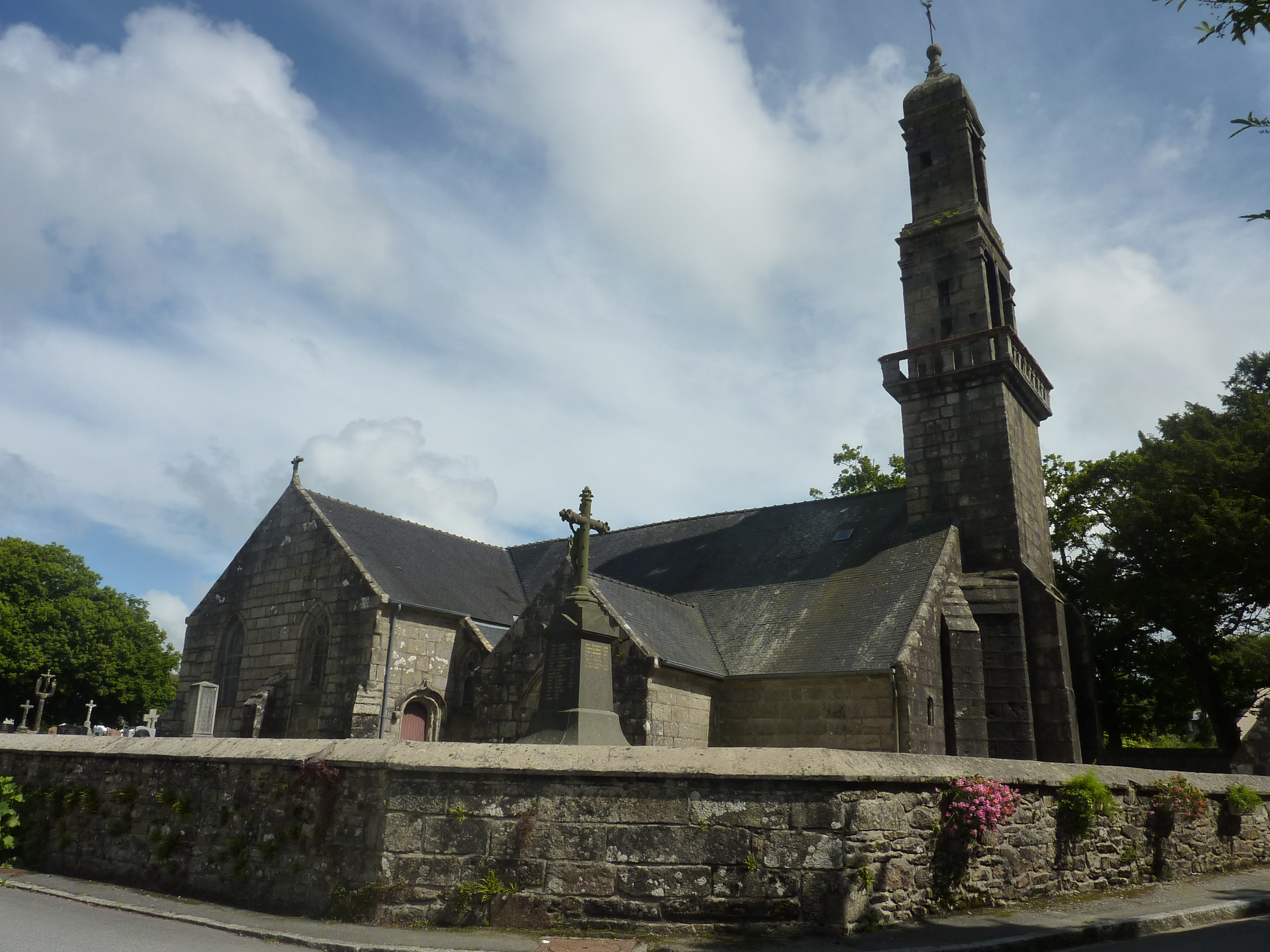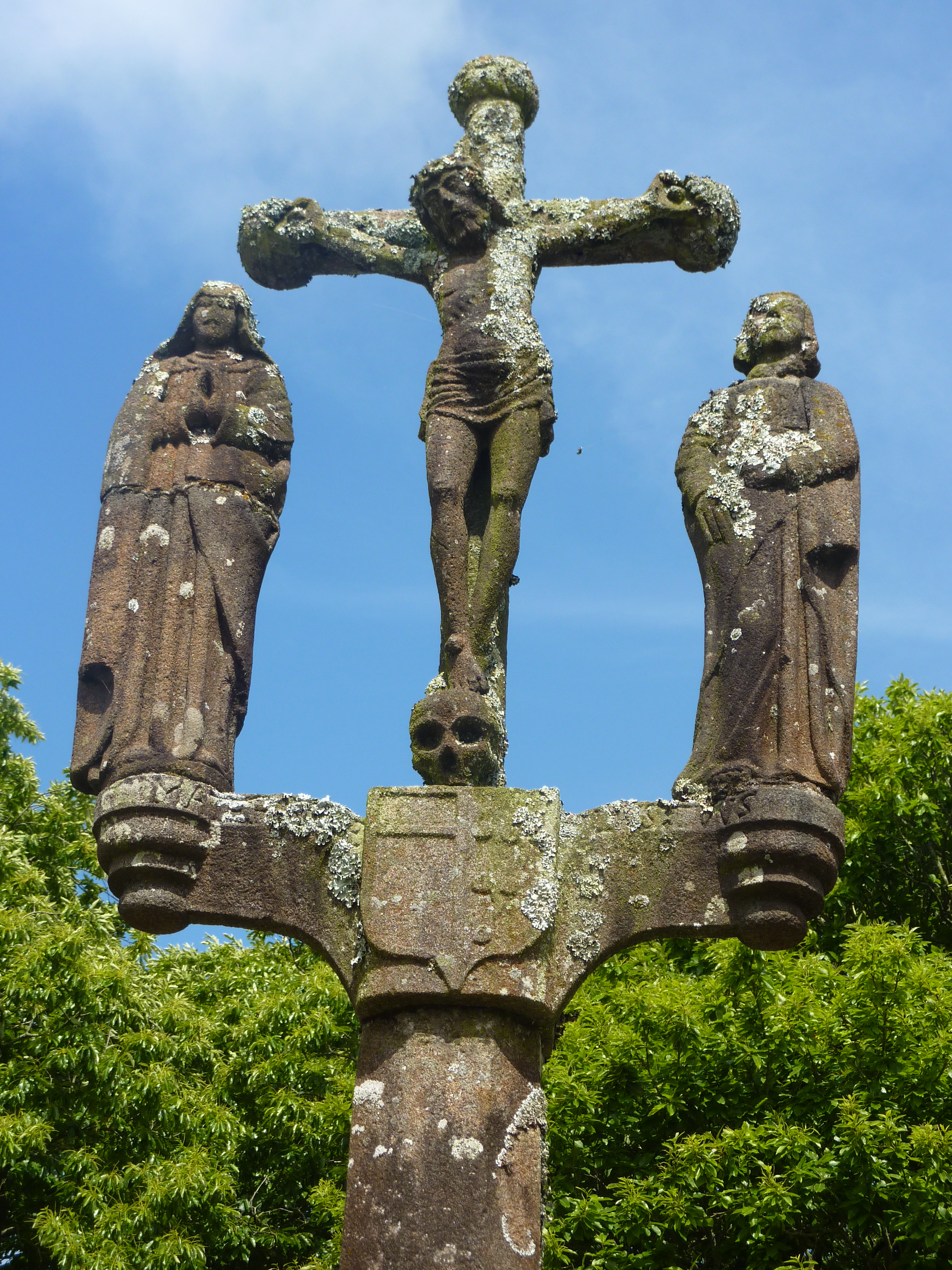Saint Divy Parish Close on:
[Wikipedia]
[Google]
[Amazon]
 The Saint Divy Parish close (
The Saint Divy Parish close (

 The church has two calvaries, but firstly, and situated east of the enclos paroissial's grass enclosure ("placître"), there is an octagonal pedestal with the inscription in Gothic letters "LE PREMIER IOR DAOUEST L’AN MIL VCV". The first actual calvary dates to 1562 and stands by the enclos paroissial's east entrance. It comprises three crosses on pillars and effectively forms the enclos paroissial's entrance. On the central cross there is a "Vierge de Pitié" on the reverse side of the crucified Jesus and a depiction of Mary Magdalene at the base. The second calvary is located in the cemetery and dates to 1652. It has statues of the Virgin Mary and John the Evangelist. This calvary was transferred to Saint Divy from Kerdalaës in 1966.
The church has two calvaries, but firstly, and situated east of the enclos paroissial's grass enclosure ("placître"), there is an octagonal pedestal with the inscription in Gothic letters "LE PREMIER IOR DAOUEST L’AN MIL VCV". The first actual calvary dates to 1562 and stands by the enclos paroissial's east entrance. It comprises three crosses on pillars and effectively forms the enclos paroissial's entrance. On the central cross there is a "Vierge de Pitié" on the reverse side of the crucified Jesus and a depiction of Mary Magdalene at the base. The second calvary is located in the cemetery and dates to 1652. It has statues of the Virgin Mary and John the Evangelist. This calvary was transferred to Saint Divy from Kerdalaës in 1966.
File:Saint-Divy (29) Église Saint-Divy Lambris peints. Détail 05.JPG, Saint Divy on his death bed. Part of one of the paintings on the vault panels in the roof of the Église Saint-Divy
File:Saint-Divy (29) Église Saint-Divy Lambris peints. Détail 16.JPG, Detail from one of the St Divy murals.
File:Saint-Divy (29) Église Saint-Divy Lambris peints. Détail 14.JPG, Part of the painting covering the announcement of Saint Divy's birth.
File:Saint-Divy (29) Église Saint-Divy Charpente 06.JPG
File:Saint-Divy (29) Église Saint-Divy Charpente 04.JPG, A Blochet
 The Saint Divy Parish close (
The Saint Divy Parish close (enclos paroissial
Parish close is a translation of the French term ''enclos paroissial''. It refers to a number of locations in Brittany, mainly though not exclusively in the historic diocese of Léon, corresponding roughly to the northern half of the department o ...
) is located at Saint-Divy
Saint-Divy (; ) is a commune in the Finistère department of Brittany in north-western France.
Population
Inhabitants of Saint-Divy are called in French ''Saint-Divyens''.
See also
*Communes of the Finistère department
*Saint Divy Parish cl ...
in the arrondissement of Brest
Brest may refer to:
Places
*Brest, Belarus
**Brest Region
**Brest Airport
**Brest Fortress
*Brest, Kyustendil Province, Bulgaria
*Břest, Czech Republic
*Brest, France
**Arrondissement of Brest
**Brest Bretagne Airport
** Château de Brest
*Brest, ...
in Brittany
Brittany (; french: link=no, Bretagne ; br, Breizh, or ; Gallo language, Gallo: ''Bertaèyn'' ) is a peninsula, Historical region, historical country and cultural area in the west of modern France, covering the western part of what was known ...
in north-western France
France (), officially the French Republic ( ), is a country primarily located in Western Europe. It also comprises of Overseas France, overseas regions and territories in the Americas and the Atlantic Ocean, Atlantic, Pacific Ocean, Pac ...
. This enclos paroissial is centered on the Église de Saint-Divy which was built in two stages, the first in 1531. It has been a listed historical monument
A monument is a type of structure that was explicitly created to commemorate a person or event, or which has become relevant to a social group as a part of their remembrance of historic times or cultural heritage, due to its artistic, his ...
since 1995. Eglise Saint-Divy
Description
There were major changes made to the church's interior in 1676 when, along with other work, the panels in the roof vaults were painted with scenes from the life of Saint Divy. Asacristy
A sacristy, also known as a vestry or preparation room, is a room in Christian churches for the keeping of vestments (such as the alb and chasuble) and other church furnishings, sacred vessels, and parish records.
The sacristy is usually located ...
was added to the southern flank of the chevet
In architecture, an apse (plural apses; from Latin 'arch, vault' from Ancient Greek 'arch'; sometimes written apsis, plural apsides) is a semicircular recess covered with a hemispherical vault or semi-dome, also known as an ''exedra''. In ...
in the 18th century and the bell tower, which had been hit by lightning, was reconstructed in 1823. The calvary at the enclos paroissial's entrance dates to the 16th century, as does the second calvary which is located in the cemetery. The church, the enclosure wall and the calvary by the entrance were all listed as recently at 1995. The parish church of Saint Divy comprises transept
A transept (with two semitransepts) is a transverse part of any building, which lies across the main body of the building. In cruciform churches, a transept is an area set crosswise to the nave in a cruciform ("cross-shaped") building withi ...
and choir
A choir ( ; also known as a chorale or chorus) is a musical ensemble of singers. Choral music, in turn, is the music written specifically for such an ensemble to perform. Choirs may perform music from the classical music repertoire, which ...
and three bays. The north porch dates to 1629. Amongst the stained glass windows, that depicting the triumph of the Virgin Mary is outstanding and includes images of 90 people as well as the portrait of Hervé de La Palue who donated the window to the church. The Rosary
The Rosary (; la, , in the sense of "crown of roses" or "garland of roses"), also known as the Dominican Rosary, or simply the Rosary, refers to a set of prayers used primarily in the Catholic Church, and to the physical string of knots or b ...
Altar had an altarpiece illustrating the fifteen mysteries of the Rosary and the altar dedicated to the dead ("Les Trépassés") has statues in wood depicting Saints Isidore and Zite dressed in the costume of the lower Brittany region. The church has a statue of Saint Divy dated 1533 and a stoup
A holy water font or stoup is a vessel containing holy water which is generally placed near the entrance of a church. It is often placed at the base of a crucifix or religious representation. It is used in the Catholic Church, Anglican Churches ...
(bénitier) in the Renaissance
The Renaissance ( , ) , from , with the same meanings. is a period in European history marking the transition from the Middle Ages to modernity and covering the 15th and 16th centuries, characterized by an effort to revive and surpass ideas ...
style dating to 1623. There is a confessional
A confessional is a box, cabinet, booth, or stall in which the priest in some Christian churches sits to hear the confessions of penitents. It is the usual venue for the sacrament in the Roman Catholic Church and the Lutheran Churches, but sim ...
in the church and the baptismal font has a baldaquin
A baldachin, or baldaquin (from it, baldacchino), is a canopy of state typically placed over an altar or throne. It had its beginnings as a cloth canopy, but in other cases it is a sturdy, permanent architectural feature, particularly over h ...
. There is no ossuary in the enclos as it was demolished, albeit in the 20th century, and the traditional south porch is in fact positioned to the north of the church.
Calvaries

 The church has two calvaries, but firstly, and situated east of the enclos paroissial's grass enclosure ("placître"), there is an octagonal pedestal with the inscription in Gothic letters "LE PREMIER IOR DAOUEST L’AN MIL VCV". The first actual calvary dates to 1562 and stands by the enclos paroissial's east entrance. It comprises three crosses on pillars and effectively forms the enclos paroissial's entrance. On the central cross there is a "Vierge de Pitié" on the reverse side of the crucified Jesus and a depiction of Mary Magdalene at the base. The second calvary is located in the cemetery and dates to 1652. It has statues of the Virgin Mary and John the Evangelist. This calvary was transferred to Saint Divy from Kerdalaës in 1966.
The church has two calvaries, but firstly, and situated east of the enclos paroissial's grass enclosure ("placître"), there is an octagonal pedestal with the inscription in Gothic letters "LE PREMIER IOR DAOUEST L’AN MIL VCV". The first actual calvary dates to 1562 and stands by the enclos paroissial's east entrance. It comprises three crosses on pillars and effectively forms the enclos paroissial's entrance. On the central cross there is a "Vierge de Pitié" on the reverse side of the crucified Jesus and a depiction of Mary Magdalene at the base. The second calvary is located in the cemetery and dates to 1652. It has statues of the Virgin Mary and John the Evangelist. This calvary was transferred to Saint Divy from Kerdalaës in 1966.
Stained glass
The much-restored stained glass window dates to 1531 and shows the influence of Dürer and Flemish masters of staining glass. The three lancets on the right hand side cover the principal subject of the window, theAssumption
Assumption, in Christianity, refers to the Assumption of Mary, a belief in the taking up of the Virgin Mary into heaven.
Assumption may also refer to:
Places
* Assumption, Alberta, Canada
* Assumption, Illinois, United States
** Assumption Town ...
, whilst the lancet on the left acknowledges Hervé de La Palue, the donor of the window. The window also includes a depiction of Saint Michael fighting devils.
Mural paintings
The church contains six murals by an unknown painter depicting the main events in the life of Saint Divy. They date to 1676.Carpentry
The church has some examples of blochets and sablière.References
{{coord, 48.4533, -4.3356, display=title Churches in Finistère Calvaries in Brittany Parish closes in Brittany